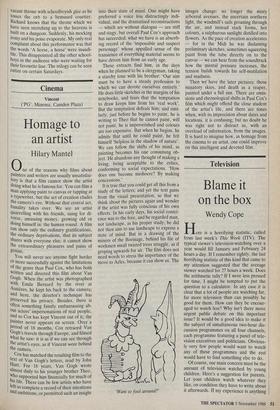Cinema
Vincent (`PG', Minema, Camden Plaza)
Homage to an artist
Hilary Mantel
0 ne of the reasons why films about painters and writers are usually unsatisfac- tory is that a film cannot show the artist doing what he is famous for. You can film a man applying paint to canvas or tapping at a typewriter, but the act of creation eludes the camera's eye. Without that central act, banality takes over. We see an artist quarrelling with his friends, suing for di- vorce, amassing money, growing old or doing himself in: the human round. A film Can show only the ordinary gratifications, the ordinary deprivations, that its subject shares with everyone else; it cannot show the extraordinary pleasures and pains of genius.
You will never see anyone fight harder or more successfully against the limitations of the genre than Paul Cox, who has both written and directed this film about Van Gogh. When the artist was photographed with Emile Bernard by the river at Asnieres, he kept his back to the camera; and here, the director's technique has Preserved his privacy. Besides, there is often something faintly embarrassing ab- out actors' impersonations of real people, and so Cox has kept Vincent out of it; the painter never appears on screen. Over a Period of 18 months, Cox retraced Van Gogh's travels through Europe, and filmed what he saw: it is as if we can see through the artist's eyes, as if Vincent were behind the camera.
Cox has matched the resulting film to the text of Van Gogh's letters, read by John Hurt. For 18 years, Van Gogh wrote almost daily to his younger brother Theo, Who supported him financially for much of his life. There can be few artists who have left so complete a record of their intentions and ambitions, or permitted such an insight
into their state of mind. One might have preferred a voice less distractingly indi- vidual, and the dramatised reconstructions — which are without dialogue — are stiff and stagy, but overall Paul Cox's approach has succeeded; what we have is an absorb- ing record of the 'impossible and suspect personage' whose appalled sense of the transience of everything material seems to have driven him from an early age.
These extracts find him, in the days when he planned to be a clergyman, taking a starchy tone with his brother: 'Our aim must be to have a steady profession to which we can devote ourselves entirely.' He does little sketches in the margins of his notebooks, and fears that the temptation to draw keeps him from his 'real work'. But the temptation defeats him; and simi- larly, just before he begins to paint, he is writing to Theo that he cannot paint, will not paint, he is impoverished and colours are too expensive. But when he begins, he admits that until he could paint, he felt himself 'helpless in the shadow of nature'. We can follow the shifts of his mind, as painting becomes his one consuming ob- ject. He abandons any thought of making a living, being acceptable to the critics, conforming to social expectations. 'How does one become mediocre? By making concessions.'
It is true that you could get all this from a study of the letters; and yet the text gains from the visual presentation, so that we think about the pictures again and wonder if the artist was fully conscious of his own effects. In his early days, his social consci- ence was to the fore, and he regarded man, not landscape, as his proper study; he did not then aim to use landscape to express a state of mind. But in a drawing of the miners of the Borinage, behind his file of workmen small twisted trees struggle, as if groping upwards for air. The film does not need words to stress the importance of the move to Arles, because it can show us. The
`Want to fool around?'
images change: no longer the misty arboreal avenues, the uncertain northern light, the windmill's sails groaning through the air, and instead stark forms, hot colours, a sulphurous sunlight distilled into flowers. As the pace of creation accelerates — for in the Midi he was disdaining preliminary sketches, sometimes squeezing paint from the tube directly on to the canvas— we can hear from the soundtrack how the mental pressure increases, the tension builds towards his self-mutilation and madness.
Then we' have the later pictures: those minatory skies, and death as a reaper, painted under a full sun. There are omis- sions and chronological shifts in Paul Cox's film which .might offend the close student of the artist's life, and there are times when, with its imprecision about dates and locations; it is confusing; but no doubt he was right not to distract us, with an overload of information, from the images. It is hard to imagine how, as homage from the cinema to an artist, one could improve on this intelligent and devoted film.


































































 Previous page
Previous page